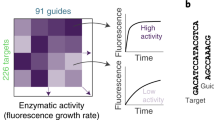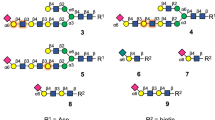Abstract
We show that comprehensive sequence-function maps obtained by deep sequencing can be used to reprogram interaction specificity and to leapfrog over bottlenecks in affinity maturation by combining many individually small contributions not detectable in conventional approaches. We use this approach to optimize two computationally designed inhibitors against H1N1 influenza hemagglutinin and, in both cases, obtain variants with subnanomolar binding affinity. The most potent of these, a 51-residue protein, is broadly cross-reactive against all influenza group 1 hemagglutinins, including human H2, and neutralizes H1N1 viruses with a potency that rivals that of several human monoclonal antibodies, demonstrating that computational design followed by comprehensive energy landscape mapping can generate proteins with potential therapeutic utility.
This is a preview of subscription content, access via your institution
Access options
Subscribe to this journal
Receive 12 print issues and online access
$209.00 per year
only $17.42 per issue
Buy this article
- Purchase on Springer Link
- Instant access to full article PDF
Prices may be subject to local taxes which are calculated during checkout




Similar content being viewed by others
References
Fleishman, S.J. et al. Computational design of proteins targeting the conserved stem region of influenza hemagglutinin. Science 332, 816–821 (2011).
Fowler, D.M. et al. High-resolution mapping of protein sequence-function relationships. Nat. Methods 7, 741–746 (2010).
Araya, C.L. & Fowler, D.M. Deep mutational scanning: assessing protein function on a massive scale. Trends Biotechnol. 435–442 (2011).
Chao, G. et al. Isolating and engineering human antibodies using yeast surface display. Nat. Protoc. 1, 755–768 (2006).
Cunningham, B.C. & Wells, J.A. High-resolution epitope mapping of hGH-receptor interactions by alanine-scanning mutagenesis. Science 244, 1081–1085 (1989).
Bowie, J.U., Reidhaar-Olson, J.F., Lim, W.A. & Sauer, R.T. Deciphering the message in protein sequences: tolerance to amino acid substitutions. Science 247, 1306–1310 (1990).
Pal, G., Kouadio, J.L., Artis, D.R., Kossiakoff, A.A. & Sidhu, S.S. Comprehensive and quantitative mapping of energy landscapes for protein-protein interactions by rapid combinatorial scanning. J. Biol. Chem. 281, 22378–22385 (2006).
Bershtein, S., Segal, M., Bekerman, R., Tokuriki, N. & Tawfik, D.S. Robustness-epistasis link shapes the fitness landscape of a randomly drifting protein. Nature 444, 929–932 (2006).
Fleishman, S.J. et al. RosettaScripts: a scripting language interface to the rosetta macromolecular modeling suite. PLoS ONE 6, e20161 (2011).
Leaver-Fay, A. et al. ROSETTA3: an object-oriented software suite for the simulation and design of macromolecules. Methods Enzymol. 487, 545–574 (2011).
Dutta, S. et al. Determinants of BH3 binding specificity for Mcl-1 versus Bcl-xL. J. Mol. Biol. 398, 747–762 (2010).
Balakrishnan, S., Kamisetty, H., Carbonell, J.G., Lee, S.I. & Langmead, C.J. Learning generative models for protein fold families. Proteins 79, 1061–1078 (2011).
Ekiert, D.C. et al. Antibody recognition of a highly conserved influenza virus epitope. Science 324, 246–251 (2009).
Sui, J. et al. Structural and functional bases for broad-spectrum neutralization of avian and human influenza A viruses. Nat. Struct. Mol. Biol. 16, 265–273 (2009).
Hietpas, R.T., Jensen, J.D. & Bolon, D.N. Experimental illumination of a fitness landscape. Proc. Natl. Acad. Sci. USA 108, 7896–7901 (2011).
Pitt, J.N. & Ferre-D′Amare, A.R. Rapid construction of empirical RNA fitness landscapes. Science 330, 376–379 (2010).
Patwardhan, R.P. et al. High-resolution analysis of DNA regulatory elements by synthetic saturation mutagenesis. Nat. Biotechnol. 27, 1173–1175 (2009).
Shultzaberger, R.K., Malashock, D.S., Kirsch, J.F. & Eisen, M.B. The fitness landscapes of cis-acting binding sites in different promoter and environmental contexts. PLoS Genet. 6, e1001042 (2010).
Wu, X. et al. Focused evolution of HIV-1 neutralizing antibodies revealed by structures and deep sequencing. Science 333, 1593–1602 (2011).
Joughin, B.A., Green, D.F. & Tidor, B. Action-at-a-distance interactions enhance protein binding affinity. Protein Sci. 14, 1363–1369 (2005).
Marshall, S.A., Vizcarra, C.L. & Mayo, S.L. One- and two-body decomposable Poisson-Boltzmann methods for protein design calculations. Protein Sci. 14, 1293–1304 (2005).
Throsby, M. et al. Heterosubtypic neutralizing monoclonal antibodies cross-protective against H5N1 and H1N1 recovered from human IgM+ memory B cells. PLoS ONE 3, e3942 (2008).
Corti, D. et al. A neutralizing antibody selected from plasma cells that binds to group 1 and group 2 influenza A hemagglutinins. Science 333, 850–856 (2011).
Efron, B., Hastie, T., Johnstone, I. & Tibshirani, R. Least angle regression. Ann. Stat. 32, 407–499 (2002).
Benatuil, L., Perez, J.M., Belk, J. & Hsieh, C.M. An improved yeast transformation method for the generation of very large human antibody libraries. Protein Eng. Des. Sel. 23, 155–159 (2010).
Studier, F.W. Protein production by auto-induction in high density shaking cultures. Protein Expr. Purif. 41, 207–234 (2005).
Kellogg, E.H., Leaver-Fay, A. & Baker, D. Role of conformational sampling in computing mutation-induced changes in protein structure and stability. Proteins 79, 830–838 (2011).
Rohl, C.A., Strauss, C.E., Misura, K.M. & Baker, D. Protein structure prediction using Rosetta. Methods Enzymol. 383, 66–93 (2004).
Sitkoff, D., BenTal, N. & Honig, B. Calculation of alkane to water solvation free energies using continuum solvent models. J. Phys. Chem. 100, 2744–2752 (1996).
Sitkoff, D., Sharp, K.A. & Honig, B. Accurate calculation of hydration free-energies using macroscopic solvent models. J. Phys. Chem. 98, 1978–1988 (1994).
Richards, F.M. Areas, volumes, packing, and protein-structure. Annu. Rev. Biophys. Bioeng. 6, 151–176 (1977).
McCoy, A.J. et al. Phaser crystallographic software. J. Appl. Crystallogr. 40, 658–674 (2007).
Adams, P.D. et al. PHENIX: a comprehensive Python-based system for macromolecular structure solution. Acta Crystallogr. D Biol. Crystallogr. 66, 213–221 (2010).
Emsley, P., Lohkamp, B., Scott, W.G. & Cowtan, K. Features and development of Coot. Acta Crystallogr. D Biol. Crystallogr. 66, 486–501 (2010).
Strong, M. et al. Toward the structural genomics of complexes: Crystal structure of a PE/PPE protein complex from Mycobacterium tuberculosis. Proc. Natl. Acad. Sci. USA 103, 8060–8065 (2006).
McDonald, I.K. & Thornton, J.M. Satisfying hydrogen-bonding potential in proteins. J. Mol. Biol. 238, 777–793 (1994).
Sheriff, S., Hendrickson, W.A. & Smith, J.L. Structure of myohemerythrin in the azidomet state at 1.7/1.3-Å resolution. J. Mol. Biol. 197, 273–296 (1987).
The PyMOL Molecular Graphics System, Version 1.5.0.1 Schrödinger, LLC.
Chen, V.B. et al. MolProbity: all-atom structure validation for macromolecular crystallography. Acta Crystallogr. D Biol. Crystallogr. 66, 12–21 (2010).
Nguyen, J.T. et al. Triple combination of oseltamivir, amantadine, and ribavirin displays synergistic activity against multiple influenza virus strains in vitro. Antimicrob. Agents Chemother. 53, 4115–4126 (2009).
Smee, D.F., Huffman, J.H., Morrison, A.C., Barnard, D.L. & Sidwell, R.W. Cyclopentane neuraminidase inhibitors with potent in vitro anti-influenza virus activities. Antimicrob. Agents Chemother. 45, 743–748 (2001).
Nguyen, J.T. et al. Triple combination of amantadine, ribavirin, and oseltamivir is highly active and synergistic against drug resistant influenza virus strains in vitro. PLoS ONE 5, e9332 (2010).
Chao, G., Cochran, J.R. & Wittrup, K.D. Fine epitope mapping of anti-epidermal growth factor receptor antibodies through random mutagenesis and yeast surface display. J. Mol. Biol. 342, 539–550 (2004).
Kunkel, T.A. Rapid and efficient site-specific mutagenesis without phenotypic selection. Proc. Natl. Acad. Sci. USA 82, 488–492 (1985).
Acknowledgements
We thank D. Fowler and S. Fields for helpful discussions and use of their in-house software to process sequencing data, C. Lee, J. Shendure and M. Dunham for experimental expertise in DNA prep and sequencing, C. Sitz and C. Santiago for technical help and the Joint Center for Structural Genomics for crystallization using the JCSG/IAVI/TSRI Rigaku Crystalmation system. This work was funded by Defense Advanced Research Projects Agency (DARPA) and the Defense Threat Reduction Agency (DTRA), and US National Institutes of Health, National Institute of Allergy and Infectious Diseases and National Institute of General Medical Sciences. The GM/CA CAT 23-ID-B beamline has been funded in whole or in part with federal funds from National Cancer Institute (Y1-CO-1020) and NIGMS (Y1-GM-1104). Use of the Advanced Photon Source (APS) was supported by the US Department of Energy, Basic Energy Sciences, Office of Science, under contract no. DE-AC02-06CH11357. The content is solely the responsibility of the authors and does not necessarily represent the official views of NIGMS or the NIH.
Author information
Authors and Affiliations
Contributions
T.A.W. and A.C. conceived the idea, performed yeast display selections, analyzed deep sequencing data, performed hemagglutinin binding experiments, and performed computational modeling. Y.S. developed the electrostatics model and ran computational modeling code. C.D. expressed and purified hemagglutinin proteins, determined and analyzed the crystal structures with the guidance of I.A.W., and performed hemagglutinin binding experiments. S.J.F. assisted with structural analysis and developed the computational modeling code. C.D.M. performed the viral neutralization experiments under the guidance of C.A.M. and P.B. H.K. carried out covariance analysis on deep sequencing data. D.B. conceived the idea, analyzed deep sequencing data, and developed the electrostatics model. All authors discussed the results and wrote the manuscript.
Corresponding author
Ethics declarations
Competing interests
T.A.W, S.J.F and D.B. have a patent application protecting proteins specified in this manuscript for use as potential influenza therapeutics.
Supplementary information
Supplementary Text and Figures
Supplementary Figures 1-19, Supplementary Tables 1-13 and Supplementary Scripts (PDF 7358 kb)
Rights and permissions
About this article
Cite this article
Whitehead, T., Chevalier, A., Song, Y. et al. Optimization of affinity, specificity and function of designed influenza inhibitors using deep sequencing. Nat Biotechnol 30, 543–548 (2012). https://doi.org/10.1038/nbt.2214
Received:
Accepted:
Published:
Issue Date:
DOI: https://doi.org/10.1038/nbt.2214
This article is cited by
-
Design of a stabilized non-glycosylated Pfs48/45 antigen enables a potent malaria transmission-blocking nanoparticle vaccine
npj Vaccines (2023)
-
Designed active-site library reveals thousands of functional GFP variants
Nature Communications (2023)
-
Protein sequence design with a learned potential
Nature Communications (2022)
-
A PROSS-designed extensively mutated estrogen receptor α variant displays enhanced thermal stability while retaining native allosteric regulation and structure
Scientific Reports (2021)
-
PacBio sequencing output increased through uniform and directional fivefold concatenation
Scientific Reports (2021)



